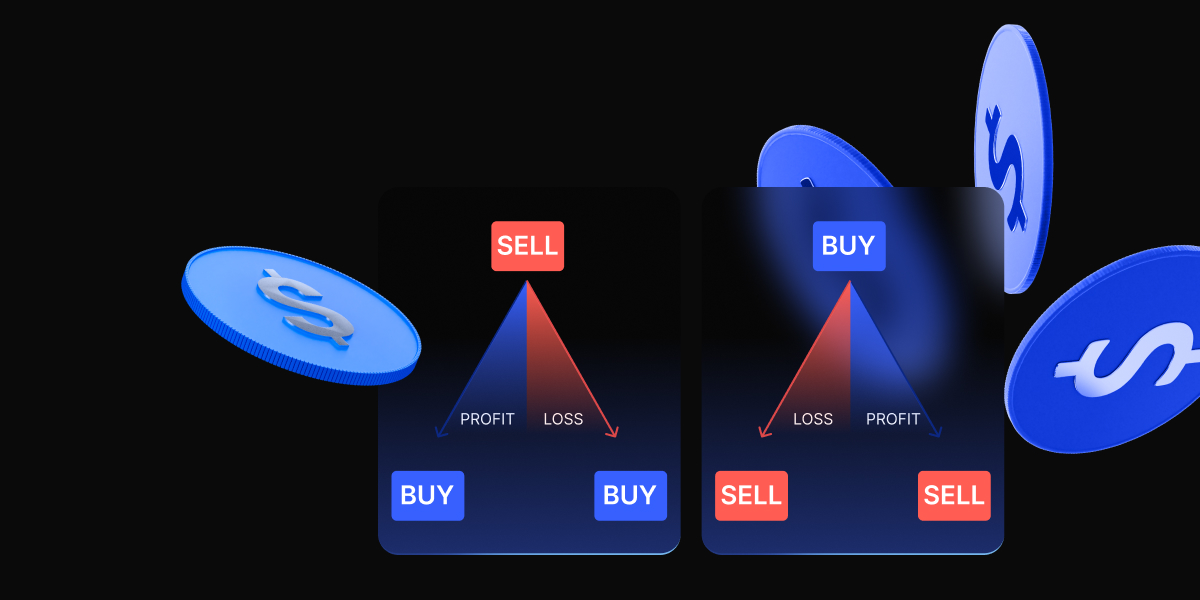Order blocks in Forex trading are like signals that reveal where the big players have made their moves. Understanding these signals can give you a significant edge in your trading decisions. They can help you spot key levels of support and resistance, trends and even predict reversals. Let’s unpack order blocks with more detail.
What are order blocks in Forex trading?
Order blocks represent price levels where large market participants make significant buying or selling decisions. These areas are characterised by clusters of orders that can influence the market’s direction.
When institutional traders place large orders, they often do so in blocks to avoid drastic price changes. This behaviour creates identifiable patterns on price charts, which traders can use to predict future price movements.
Order blocks are essential in Forex trading because they highlight areas where the market has previously experienced significant activity. These areas can act as turning points, providing traders with valuable insights into potential future price movements. Once traders can identify order blocks, they can better understand market dynamics and make more informed trading decisions.
In practice, order blocks are identified by observing previous price action and looking for areas where the price experienced significant movement or sudden changes in direction within the supply or demand zones. These areas often coincide with key support and resistance levels, making them crucial for traders to monitor.
Why order blocks matter
Order blocks are essential in Forex trading for several reasons. Firstly, they help identify key levels of support and resistance. These levels are crucial for traders as they indicate where the price is likely to pause or reverse, providing opportunities for strategic trades.
Secondly, an order block can signal potential market trends. Large market participants placing significant orders often reflect their sentiments and expectations about future price movements. By following these signals, traders can align their trading strategy with those of more informed market players, increasing their chances of success.
Lastly, understanding how an order block works can enhance a trader’s ability to manage risk. By recognising where large orders are placed, traders can set more effective stop-loss and take-profit levels, protecting their positions from unexpected market movements.
How order blocks work
Order blocks allow large market participants to execute their substantial orders without significantly disrupting the market and causing drastic changes on a price chart. Instead of placing a single, massive order that could move the market significantly, these large orders are divided into smaller blocks and executed gradually over time.
These smaller orders accumulate at a particular price level, creating an order block. Whether you’re talking about a bullish order block or a bearish order block, this concentration of orders can influence price movement, liquidity, and overall market sentiment. When the price approaches an order block, it may encounter increased buying or selling pressure, leading to potential reversals or continuations of the current trend.
Order blocks can also influence market structure and sentiment. If other traders observe significant buying or selling activity at a particular price level, they may interpret it as a signal from well-informed market participants and follow suit. This can then further reinforce the price movement.
Identifying Order Blocks
Identifying order blocks can provide valuable insights into potential market movements and trading opportunities. Here are some common methods for identifying order blocks:
Clusters of price bars or candles: look for clusters of price bars or candlesticks that indicate significant buying or selling activity at a particular price level. These clusters may appear as a series of engulfing or inside bar patterns, suggesting a concentration of orders.
Volume analysis: analyse the trading volume around a specific price level. Significant volume increases can indicate the presence of an order block, as large market participants execute their orders.
Consolidation patterns: identify ranging patterns or patterns of consolidation on the chart where the price has been trading within a narrow range. These areas may represent order blocks, as large orders are being executed gradually.
Technical indicators: use technical indicators like the Relative Strength Index (RSI), Moving Average Convergence Divergence (MACD), or Bollinger Bands to identify potential order blocks. Divergences or extreme readings on these indicators can signal areas of significant buying or selling pressure.
Support and resistance levels: identify areas of significant support and resistance on the chart, as these levels often coincide with order blocks. Large market participants may place orders around these key levels, creating order blocks.
News events: monitor news and economic events that could trigger order blocks as traders adjust their positions in response to new information or market conditions.
Examples of order blocks in Forex trading
Now, let’s explore some specific examples of order blocks in Forex trading.
Consolidation zones
Consolidation zones are areas where the price is relatively stagnant, trading within a narrow range. During these periods, large market participants may gradually execute their orders, creating order blocks at the upper and lower boundaries of the consolidation zone. These order blocks can act as support and resistance levels, potentially leading to breakouts or reversals.
Breakout zones
Breakout zones occur when the price moves out of a consolidation area, either to the upside or downside. As the price breaks through a key level, large market participants may place orders anticipating a potential trend continuation or reversal. These orders can create order blocks at the breakout level, influencing the ensuing price movement.
Pullback zones
Pullback zones are areas where the price reverses from a significant upward trend, retracing a portion of the previous move. Large market participants may place orders at these pullback levels, creating order blocks that can act as support levels for the continuation of the uptrend or as resistance levels for a potential trend reversal.
Reversal zones
Reversal zones occur when the price reaches a key support or resistance level and reverses direction. Large market participants may place orders at these levels, anticipating a potential trend reversal. These orders can create order blocks that can influence the upcoming price movement, either confirming the reversal or continuing the previous trend.
Order block trading strategies
Order blocks can be incorporated into various trading strategies to capitalise on potential market movements and manage risk effectively. Here are some common strategies:
Support and resistance levels: traders can use order blocks to identify key support and resistance levels, which can be used as trade entry and exit points. By placing orders around these levels, traders can capitalise on trend reversals or continuations.
Breakout trading: order blocks can trade breakouts from consolidation patterns or ranges. Traders can place buy orders above or sell orders below the order block, with stop loss orders placed beyond the order block level.
Trend reversals: by identifying order blocks at key support or resistance levels, traders can spot potential trend reversals and make informed trading decisions. For example, if the price approaches an order block and fails to break through, it may signal a possible reversal, prompting traders to enter a position in the opposite direction.
The advantages and disadvantages of using order blocks
Advantages
Improved market understanding: order blocks provide valuable insights into the behaviour of large market participants. By understanding where these players have placed their orders, traders can better understand market sentiment and anticipate potential price movements.
Enhanced trading accuracy: using order blocks to identify key support and resistance levels can improve trading accuracy. By understanding where these levels are, traders can make more informed decisions and increase their chances of success.
Better risk management: order blocks can help traders manage risk more effectively. By identifying the order block range where the price will likely react, traders can set up stop loss and take profit orders to protect their positions and maximise profits.
Increased profit potential: traders can increase their profit potential by using order blocks to anticipate potential trend reversals and breakouts. This approach allows traders to capitalise on market movements and make more informed trading decisions.
Disadvantages
Complexity: identifying and using order blocks can be complex, especially for novice traders. This approach requires a deep understanding of market dynamics and the behaviour of large market participants.
Time-consuming: analysing charts and identifying order blocks can be time-consuming. Traders must invest significant time and effort to understand the market and identify potential order blocks.
Potential for false signals: order blocks can sometimes provide false signals, leading to potential losses. Traders need to use additional technical analysis tools and indicators to confirm the presence of order blocks and avoid potential pitfalls.
Market volatility: order blocks can be affected by market volatility, leading to unexpected price movements. Traders need to be aware of market conditions and adjust their strategies accordingly to avoid potential losses.
Conclusion
Order blocks are a crucial concept in Forex trading, providing valuable insights into the behaviour of large market participants and key levels of support and resistance. By understanding and using order blocks, traders can improve their trading accuracy, manage their risk more effectively, and increase their profit potential.
However, this approach requires a deep understanding of market dynamics and the behavior of large market participants. By combining order blocks with other technical analysis tools and indicators, traders can make more informed trading decisions and capitalise on market opportunities.
The content provided here is for informational purposes only. It is not intended as personal investment advice and does not constitute a solicitation or invitation to engage in any financial transactions, investments, or related activities. Past performance is not a reliable indicator of future results.
The financial products offered by the Company are complex and come with a high risk of losing money rapidly due to leverage. These products may not be suitable for all investors. Before engaging, you should consider whether you understand how these leveraged products work and whether you can afford the high risk of losing your money.
The Company does not accept clients from the Restricted Jurisdictions as indicated in our website/ T&C. Some services or products may not be available in your jurisdiction.
The applicable legal entity and its respective products and services depend on the client’s country of residence and the entity with which the client has established a contractual relationship during registration.




